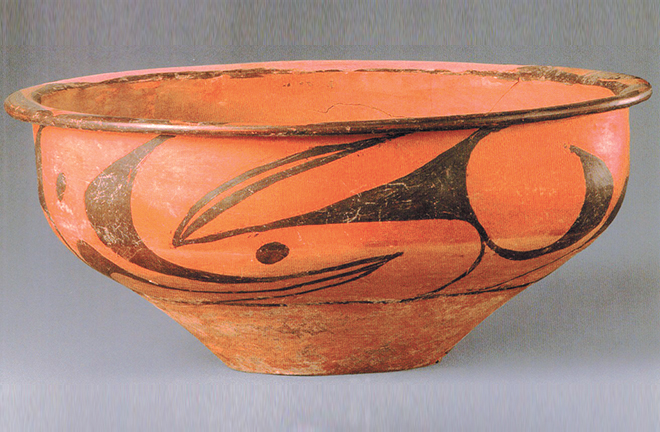China’s modern archaeology celebrates centennial

Painted pottery of the Yangshao culture Photo: PROVIDED TO CSST
The year 2021 marks the centenary of the discovery of the Yangshao Culture, which is considered the beginning of modern archaeology in China.
President Xi Jinping has called for developing archaeology with Chinese features, style, and ethos.
Xi, also general secretary of the Communist Party of China Central Committee and chairman of the Central Military Commission, made the remarks in a congratulatory letter on the 100th anniversary of the discovery of the Yangshao Culture and the beginning of modern archaeology in the country.
Over the past 100 years, generations of archaeologists have made a series of major discoveries through tireless efforts, playing an important role in making the extensive and profound Chinese civilization better understood, Xi noted, adding that these discoveries have highlighted the great contributions made by the Chinese civilization to civilizations of the world, according to the Xinhua News Agency.
On October 18th, the Third China Archaeology Conference opened in Sanmenxia City, Henan Province. Under the theme of “Developing Archaeology with Chinese Features, Style, and Ethos,” the conference looked back at the glorious history and great achievements of Chinese archaeology in the past century.
Yangshao Culture
The Yangshao Culture is named after Yangshao Village, located in Sanmenxia City, Henan Province. In October 1921, this small village on the bank of the Yellow River welcomed a group of domestic and international scholars. With hand shovels, they dug up the painted pottery of a culture dating back 7,000 years, thus ushering in modern Chinese archaeology.
Over the next 100 years, Chinese archaeology gradually developed and matured, and has made great achievements. The discovery of famous archaeological cultures such as at Yin Xu, Erlitou, Liangzhu, Hongshan, Shimao, Sanxingdui, among others, has constantly refreshed people’s original understanding of Chinese history.
“The excavation of the Yangshao site in 1921 was China’s first archaeological excavation in the scientific sense. It was the first time to recognize the appearance of prehistoric culture represented by painted pottery,” said Wang Wei, chairman of the Chinese Archaeological Society and Member of the Chinese Academy of Social Sciences.
Among Chinese prehistoric cultures, the Yangshao culture is the archaeological culture with the longest research time and the richest academic achievements, in the view of Yuan Guangkuo, a professor from the School of History at Capital Normal University. The most fascinating remains of the Yangshao culture are the painted pottery with mysterious patterns and arbitrary lines.
A series of major archaeological discoveries in Henan have demonstrated the province’s central position in the development of Chinese civilization, said Liu Haiwang, president of the Henan Provincial Institute of Cultural Heritage and Archaeology. For more than 3,000 years, the Yellow River Basin had been the political, economic, and cultural center of China. The development level of ancient civilization represented by the Yellow River Basin had long been in the forefront of the world.
Origin of civilization
The origin of civilization is one of the important topics of archaeology, and several generations of archaeologists have been committed to this endeavor. Han Jianye, a professor from the School of History at Renmin University of China, noted that after the Yangshao culture, the middle reaches of the Yellow River became the center of early China several times. Regardless of the changes in the early Chinese regional culture, the “gene” of the Yangshao culture has been passed down through history.
The Xia (c. 21st–16th century BCE) and Shang (c. 16th–11th century BCE) dynasties were the initial stages of the formation and development of ancient states in China. Although academia still disputes the Xia Dynasty and Xia culture, archaeological evidence shows that the Xia Dynasty did exist objectively.
In recent years, the great achievements made by Chinese archaeology have gradually gained the attention and affirmation of the world archaeology community. Jessica Rawson, a professor at University of Oxford, believes that new archaeological discoveries from China have allowed the world to see the diversity of early Chinese history, and the great achievements of ancient Chinese civilization can be understood by the world. The latest research on scientific and technological archaeology has also deepened our understanding of archaeology in various periods.
“The development of Chinese archaeology over the years is amazing!” said Kazuo Miyamoto, a professor at Kyushu University in Japan. From the recent excavation and survey of the Sanxingdui site, it can be seen that throughout the world, Chinese archaeology has the most advanced excavation and survey technology and level, Miyamoto said.
Ian Hodder, a professor from Stanford University, pointed out that the study of Chinese archaeology in the past 100 years has truly changed our understanding of global human stories. China’s historical development process is unique. In recent years, the explanation of this process has gradually become clearer with exciting research results.
Edited by JIANG HONG

 PRINT
PRINT CLOSE
CLOSE